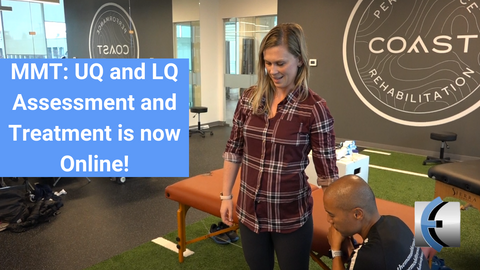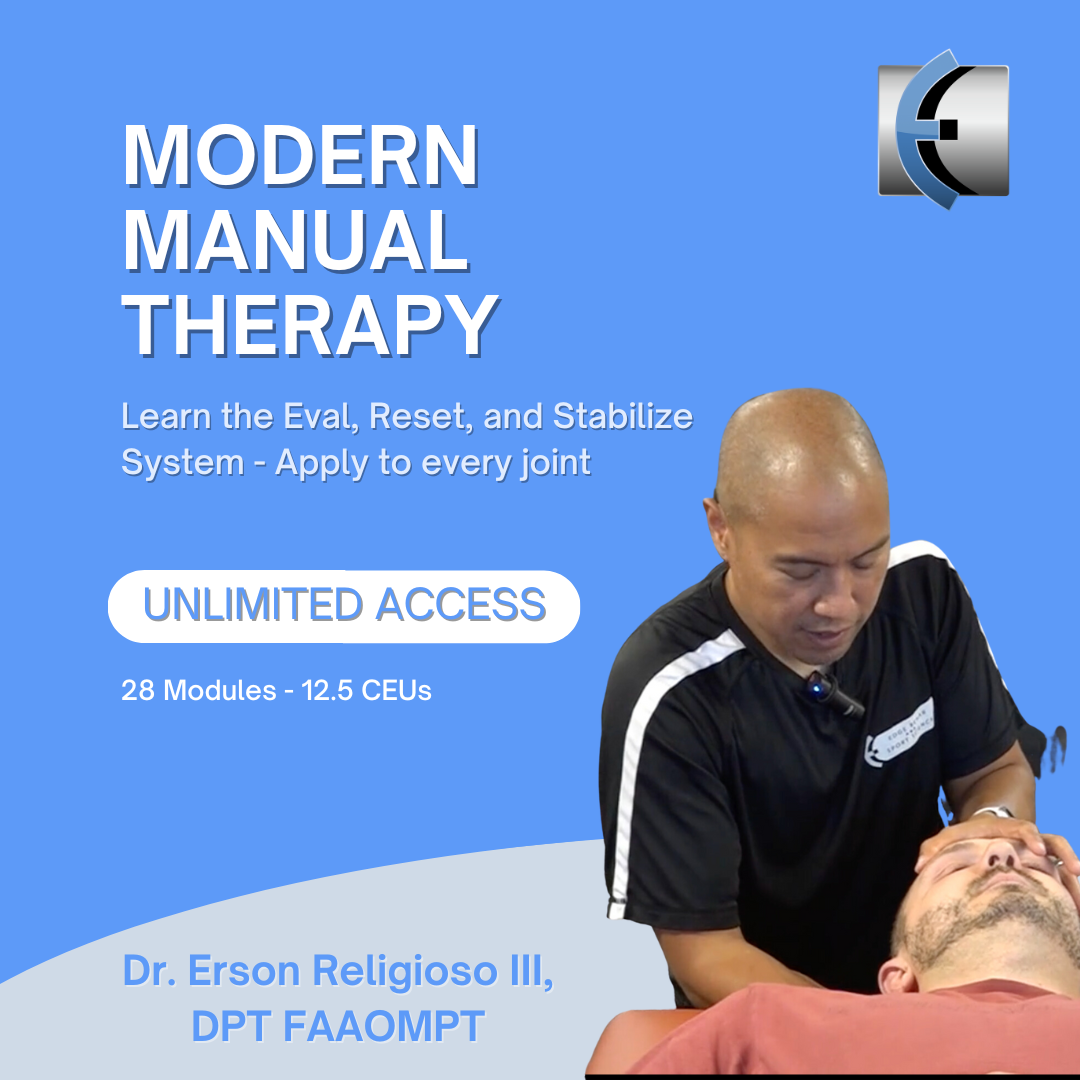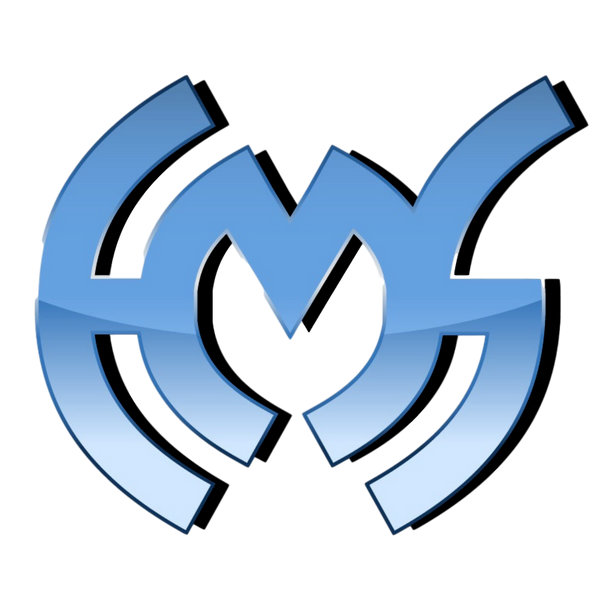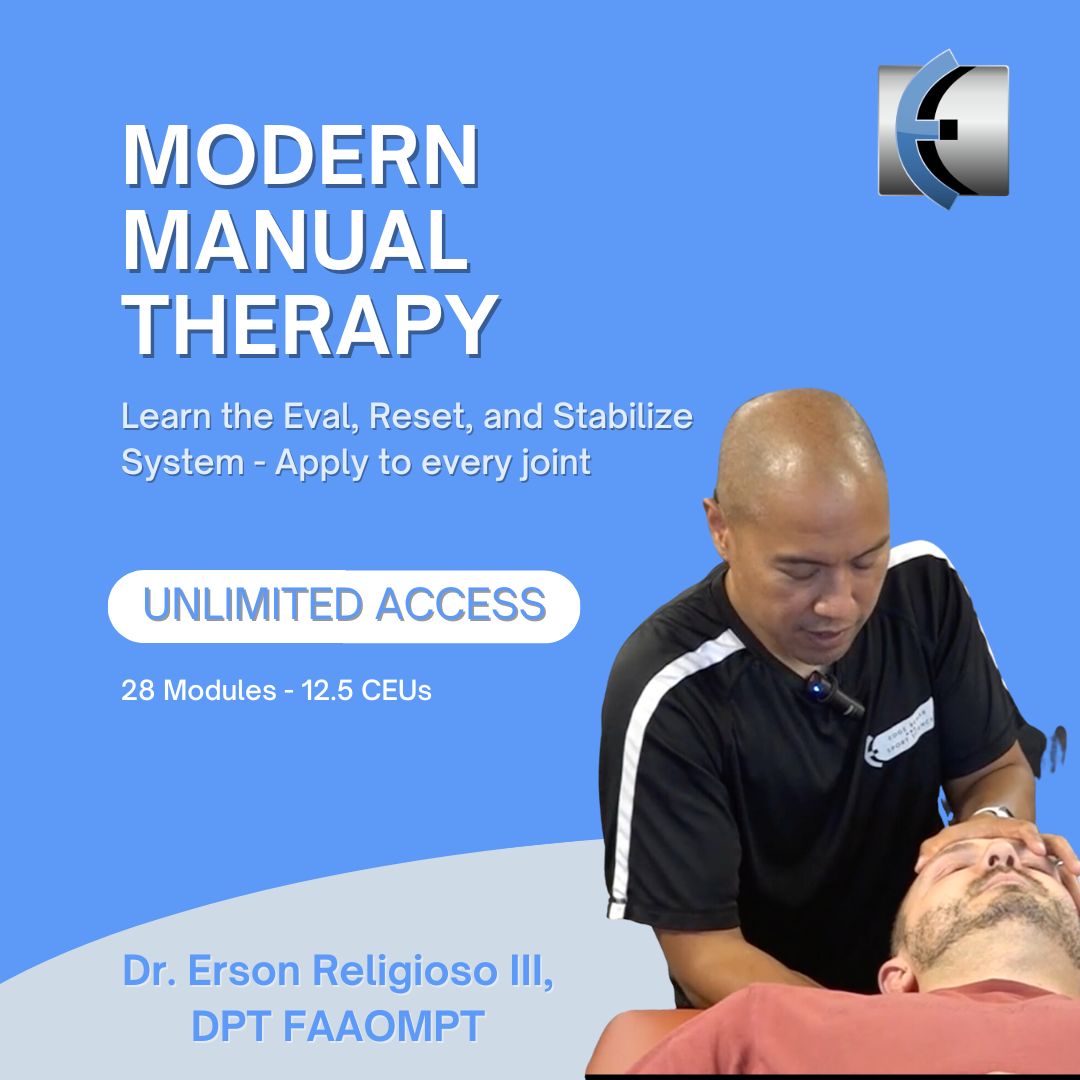Get Better Outcomes, Faster
The Eclectic Approach to the Upper and Lower Quarter will teach you easy assessments and even easier treatments for most common issues you see in your clinic everyday. Study at your own pace. Apply what you learn as you learn it. By the end you’ll have 13 CEUs and patients who can’t wait to tell their friends and family about you.
Minutiae Not Included
Most manual therapy courses go something like this.
You travel to a course and spend the next 2-5 days listening to lectures and practicing techniques.
By the end of it you have 100 new techniques, 60 types of assessments, and a whole workbook of theory to try to wrap your head around.
And that’s just Level 1 from this guru.
There are, of course, more gurus, with more levels, and more courses, all diving deeper into the minutiae of their approach with hyper-specific assessments and hyper-specific treatments.
All of this minutiae and specificity are very effective at selling more expensive courses, but how much does it really help you get better outcomes, faster for your patients?
Ideally you could take all of the courses, read all of the research, and create your own system built around the best elements from each approach.
You would discard all of the needless complexity and distill it into simple assessments that uncover simple patterns that respond to even simpler treatments.
Luckily, you don’t have to spend all of the money and do all of that work, because I’ve done it for you.
I’ve spent my entire career taking courses from the gurus, studying their approaches, practicing, learning the minutiae, reading the research, and testing what works with my patients.
The result is The Eclectic Approach to the Upper and Lower Quarter. The course is 28 modules (and 13 CEUs!) of the best theory, movements screens, assessments, treatments, and self care recommendations for the most common issues you see in your clinic everyday.
The Easiest Knee Test Ever is an example of an easy knee assessment and treatment you can immediately implement into your clinical practice. Like all the assessments and treatments in Modern Manual Therapy, you won't need to practice hundreds of hours of specific hand placements and palpatory skills to get rapid results.
What Will You Learn?
The Eclectic Approach to the Upper and Lower Quarter will provide you with assessment and treatment tools for working with the cervical, thoracic, and lumbar spine as well as the shoulder, elbow, wrist, hip, knee and ankle.
By the end you will be able to identify and effectively treat the most common clinical patterns in each body area.
You will learn…
Simple, evidence informed assessments designed to help you quickly identify clinical patterns
-
Movement screens for each body area
-
Repeated motions examinations
-
Neurodynamic testing with the median, ulnar, radial, sciatic, and femoral nerves
Easy, Effective treatments that work without having to spend hours perfecting them.
-
Instrument Assisted Soft Tissue Mobilization (IASTM) using the EDGE Tool
-
Functional Mobilizations using EDGE Compression bands
-
Neurodynamic treatments
-
Positional inhibition techniques
-
Isometrics
-
And more
An emphasis on patient education and self-care to make sure your patients keep making gains between sessions
-
Home exercises
-
Repeated motions based resets
-
Resets using the EDGE Mobility Band
-
And more
All elements of the course are delivered within the framework of best current evidence, a modern understanding of pain science, and the principles of an Eval, Reset, Stabilize approach.
Plus, Eclectic Approach to the Upper and Lower Quarter is fully online. You have immediate access after purchase and you can study at your own pace.
That means you can apply what you learn, as you learn it for the biggest impact possible
Everything You Need for "Guru" Like Outcomes
I’ve been teaching the Eclectic Approach to the Upper and Lower Quarter live for years. Now, the full 2-day course has been recorded and divided into 13 hours delivered over 28 video modules. By the end you’ll have a clear framework to get better outcomes in less time.
Understanding the Eclectic Approach
Before we dive into the techniques you’ll get 5 lectures with everything you need to get a modern understanding of pain, manual therapy, and how they inform the Eclectic Approach.


Module 3 and 4: Practice Patterns of the Upper Quarter
Learn the easiest way to find and treat rapid responders with neck and arm pain.


Module 5 and 6: Practice Patterns of the Shoulder, Thoracic Spine and Ribs
Explore how to find rapid responders in the shoulder and thoracic spine, plus you’ll start learning techniques using the EDGE tool, EDGE band, functional mobilizations, and more.
Module 7: Upper Quarter Neurodynamics
Dial in your neurodynamic assessments, then expand your skills with the EDGE tool and EDGE band with pain-free techniques to improve neurodynamic mobility.
Module 8: Practice Patterns of the Elbow and Wrist
Learn to identify the most common patterns of dysfunction in the elbow and address them using sustained glides with repeated movements, EDGE band techniques and more
Module 9: Upper Quarter Positional Inhibition
Soft tissue techniques don’t need to be painful to work. This module will teach you how to make them less painful and more effective.
Modules 10, 11 and 12: Cervical Problem Solving
Patients in the clinic always end up being more complex than what you learn in a course. Dr. E takes you through how to address the most common challenges you’ll come across.
Module 13: Upper Quarter Position Inhibition Part 2
Discover more pain-free techniques to rapidly reduce pain and improve mobility.
Module 14: Troubleshooting Overhead Mobility
Finish up the upper quarter by learning a repeatable screen for overhead mobility and a variety of techniques to improve it.
Module 15: Practice Patterns of the Lumbar Spine and Hip
Learn the assessments for the lumbar spine and hip that will help you find and treat rapid responders with low back and leg pain.
Module 16: Practice Patterns for the Ankle and Squatting
Continue your lower quarter examination down the chain with the squat, a novel ankle assessment, and techniques to address common patterns of dysfunction in these areas.
Module 17: Tibial Practice Patterns
Everyone assesses knee flexion and extension. In this module you will learn to assess tibial rotations and link the findings to common practice patterns. Then learn treatment techniques with the EDGE band.
Module 18: Practice Patterns of the Knee
Continue your examination of the knee with a simple, repeatable assessment and a counter-intuitive EDGE Tool treatment that works.
Module 19: Breathing Assessment and Hip Inhibition
Expand your examination with a simple breathing assessment and techniques to improve breathing mechanics.
Module 20: The Hip and Neurodynamics
Learn a novel technique and home exercise to rapidly improve toe touch and hip mobility.
Module 21: Lumbar Problem Solving
Explore common challenges you’ll likely encounter in applying the lower quarter practice patterns to the clinic. Dr. E takes you through how to address the most common challenges you’ll come across.
Module 22: The Lateral Chain Arm Pull Test and Leg Stability
Add another lower quarter assessment you weren’t taught in school and the techniques to address any issues you find.
Module 23: Eval, Reset, Stabilize for Hip Extension
Learn a simple but effective assessment for hip extension. Next apply techniques to reset and improve the ROM. And finally stabilize the area with simple cues to make a common hip exercise far more effective.
Module 24: Low Threshold Isometrics for the Upper and Lower Quarter
Complete the course with this gentle, pain-free technique that provides surprising results in pain and movement.
Meet Your Instructor

Dr. Erson Religioso III, DPT, MS, MTC, CertMDT, CertCFC, CertMST, FAAOMPT
Founder The Eclectic Approach and Modern Manual Therapy
Dr. E is a fellowship trained cash based PT practice owner, entrepreneur, blogger, and sought after lecturer in the topic of Modern Manual Therapy. Erson graduated from D'Youville College in 1998 with a dual Bachelor's of Science and Master's of Science in Physical Therapy. His interests in Orthopaedics and Manual Therapy lead him to pursue a Doctor of Physical Therapy degree from the University of St. Augustine. Studying under Stanley Paris, Ph.D, PT, internationally known for his manual skills and knowledge of the spine as well as his distinguished faculty, Dr. Religioso earned his DPT and Manual Therapy Certification in 2000. He later became credentialed in Mechanical Diagnosis and Treatment of the Spine in 2000.
Dr. Religioso became certified in evaluation and treatment of oromaxillary, craniofacial, and temporomandibular pain in 2005; this from extensive training and certification from Dr. Mariano Rocabado, PT, of Chile, one of the world’s foremost experts in treatment of temporomandibular joint dysfunction. Later in 2005, Dr. E obtained Fellow status in the American Academy of Orthopaedic Manual Physical Therapists
He has a #CashPT Practice in the Buffalo, NY area, EDGE Rehab and Sport Science, where he specializes in TMD, headaches, spinal care, runners, gymnasts, and chronic pain. His focus is seeing the patient as little as possible, and empowering them with education, self assessment and treatment strategies.
What are other clinicians saying about MMT?
Basically, I felt like before the course, I had tried to perform your system and techniques but usually wasn’t too successful because I didn’t fully understand the minor details (hand placements, sets/reps, etc). I feel like now this week I have been able to “fully unleash” the system if that makes sense. I have had about 5 major breakthroughs this week in either new patients or existing ones that I was having trouble week in 2.5 days. I just feel much more confident with it.
Ryan Ruben, DPT, PT, MS


Thanks so much Dr. E! Really enjoyed and just finished the theory and makes a lot of sense to me. I'm excited to treat people in a more painless approach as possible. That was always my desire and now it's more clear that it will be as effective and a bonus to put less stress on me as a practitioner. It felt so much easier for a long time to explain you are 'breaking up scar tissue' and 'releasing muscles'
Tyron Walters, DC
This seminar opened my eyes to the world of modern pain science. Over the last decade we’ve come to realize that pain is simply not the result of muscle weakness or even tissue damage. Gone are the days of thinking we are releasing “adhesions” or breaking up “scar-tissue”. It’s much more complicated than that.
Michael Mash, DPT, CSCS, FMS


..thanks for being so willing to share your knowledge and experience. I have greatly benefitted from your blog and channel! I was telling my wife just the other day that I'm more excited about my practice and getting better outcomes than I have in 20 years.
Max Selisch, PT

Our Risk-Free Guarantee
▾▿▾▿▾▿▾▿▾
All Eclectic Approach Seminars are digital and come with a 30-day money-back guarantee.
EDGE Mobility System
Seminario en línea sobre terapia manual moderna: el enfoque ecléctico para la evaluación y el tratamiento de la calidad de la audición y la calidad de la voz
Seminario en línea sobre terapia manual moderna: el enfoque ecléctico para la evaluación y el tratamiento de la calidad de la audición y la calidad de la voz
No se pudo cargar la disponibilidad de retiro

¡Ya está aquí! ¡El curso más popular de Modern Manual Therapy finalmente está disponible en su totalidad! Filmado y editado profesionalmente, ¡es el curso completo de 2 días en 26 módulos increíbles! ¡12,5 horas de contenido!
Elegible para 12,5 CEU : ¡aprobado en la mayoría de los estados para CEU de PT, incluido Nueva York!
Si ha estado siguiendo al Dr. E en línea en las redes sociales, sus podcasts o blogs, sabe que la evaluación y el tratamiento pueden ser simples y no necesitan 5 niveles para lograr respuestas rápidas de la mayoría de los pacientes.
Mejore su caja de herramientas existente con un marco basado en evidencia para la evaluación y el tratamiento.
¿Ha deseado ampliar sus conocimientos aprendiendo un protocolo integral de evaluación y tratamiento del dolor y la disfunción del cuarto superior? Si es así, este curso le proporcionará las herramientas de evaluación y tratamiento para trabajar con la columna cervical, torácica y lumbar, así como con el hombro, el codo, las muñecas, la cadera, la rodilla y el tobillo.
Se utilizarán como herramientas de evaluación una evaluación exhaustiva del movimiento y movimientos repetidos. Se incluirán ejercicios para el hogar para los pacientes, ya que se hace hincapié en la educación del paciente y el autotratamiento.
El curso cubrirá:
- Los principios de evaluación, restablecimiento y estabilización
- Evaluación basada en pantalla de movimiento y movimientos repetidos
- Pruebas neurodinámicas de los nervios mediano, radial, cubital y ciático y femoral.
- Masaje de tejidos blandos asistido por instrumentos (IASTM) con la herramienta EDGE
- Tratamiento neurodinámico
- Movilización funcional de cadera, rodilla y tobillo.
- Ejercicios en casa, reinicios basados en movimientos repetidos y uso de las bandas de movilidad EDGE
- Un énfasis en la educación del paciente y el autotratamiento.
Nota: este curso es completamente en línea y, como todos nuestros medios, es únicamente digital. Al realizar la compra, recibirás de inmediato instrucciones sobre cómo mirar y obtener los materiales para seguirlo.
¿Qué dicen otros sobre nuestro seminario?
Ryan Ruben, DPT, fisioterapeuta, maestría

Michael Mash, doctor en Fisioterapia, especialista en Ciencias Aplicadas y Medicina Física

Max Selisch, fisioterapeuta



